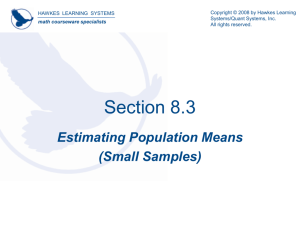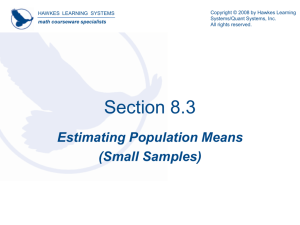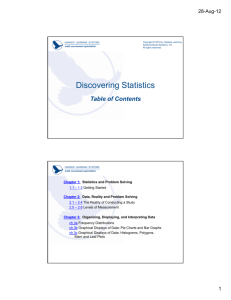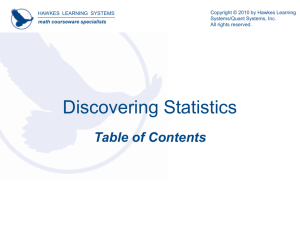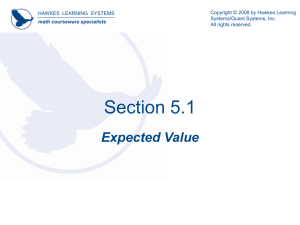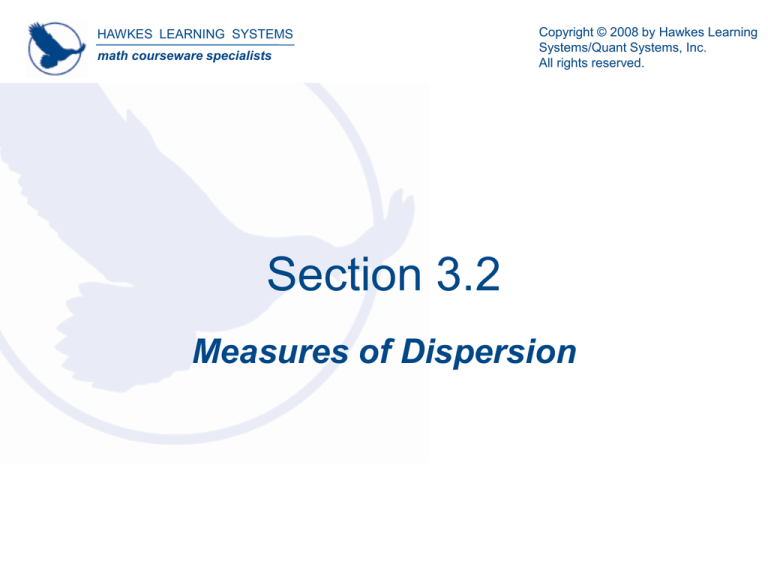
HAWKES LEARNING SYSTEMS
math courseware specialists
Copyright © 2008 by Hawkes Learning
Systems/Quant Systems, Inc.
All rights reserved.
Section 3.2
Measures of Dispersion
HAWKES LEARNING SYSTEMS
Numerical Descriptions of Data
math courseware specialists
3.2 Measures of Dispersion
• A measure of dispersion tells how
spread out the data values are.
• The measures of dispersion we will
calculate are the range, standard
deviation, and variance.
HAWKES LEARNING SYSTEMS
Numerical Descriptions of Data
math courseware specialists
3.2 Measures of Dispersion
Calculating the range:
• The range is the simplest measure of
dispersion.
• Range = Maximum - Minimum
Calculate the range of the following data sets:
a. 2 2 2 3 5 6 9 15
Solution:
15 - 2 = 13
b. 2 3 5 6 7 8
Solution:
8-2=6
HAWKES LEARNING SYSTEMS
Numerical Descriptions of Data
math courseware specialists
3.2 Measures of Dispersion
Calculating the variance:
• The variance is the average squared
deviation from the mean.
• Formula:
HAWKES LEARNING SYSTEMS
Numerical Descriptions of Data
math courseware specialists
3.2 Measures of Dispersion
Calculate the variance of the following sample data:
4.2 5.3 2.9 6.7 1.5
Solution:
First calculate the mean of the data. The mean is 4.12.
Sample Variance
xi
4.2
4.2 – 4.12 = 0.08
0.0064
5.3
5.3 – 4.12 = 1.18
1.3924
2.9
2.9 – 4.12 = –1.22
1.4884
6.7
6.7 – 4.12 = 2.58
6.6564
1.5
1.5 – 4.12 = –2.62
6.8644
HAWKES LEARNING SYSTEMS
Numerical Descriptions of Data
math courseware specialists
3.2 Measures of Dispersion
Solution (continued):
Therefore the sample variance is
When calculating the variance, round to one more decimal place
than what is given in the data.
HAWKES LEARNING SYSTEMS
Numerical Descriptions of Data
math courseware specialists
3.2 Measures of Dispersion
Calculating the standard deviation:
• The standard deviation tells the average
distance the data values lie from the mean.
• Formula:
HAWKES LEARNING SYSTEMS
Numerical Descriptions of Data
math courseware specialists
3.2 Measures of Dispersion
TI-84 Plus Instructions:
1. Press STAT, then choose Edit
2. Type the data values into L1
3. Press STAT, then CALC
4. Choose 1-Var Stats
5. Hit 2nd, and find L1 on the keypad
6. Make sure to look for the right symbol
HAWKES LEARNING SYSTEMS
Numerical Descriptions of Data
math courseware specialists
3.2 Measures of Dispersion
Calculate the standard deviation of the following sample data:
a.
3.1 4.6 2.9 5.1 2.2 4.8 3.3
Solution:
We can find the variance and then take the square
root, or we can use a calculator.
Using a calculator we see that the standard deviation
of the sample data is approximately 1.11.
b.
1.9 4.5 9.2 11.4 2.2 20.6 7.8 0.3
Solution:
Again, using a calculator we see that the standard
deviation of the sample data is approximately 6.65.
When calculating the standard deviation, round to one more
decimal place than what is given in the data.
HAWKES LEARNING SYSTEMS
Numerical Descriptions of Data
math courseware specialists
3.2 Measures of Dispersion
Empirical Rule:
• Used when a set of data is approximately
bell-shaped.
• Approximately 68% of the data lies within 1
standard deviation of the mean.
• Approximately 95% of the data lies within 2
standard deviations of the mean.
• Approximately 99.7% of the data lies within 3
standard deviations of the mean.
HAWKES LEARNING SYSTEMS
Numerical Descriptions of Data
math courseware specialists
3.2 Measures of Dispersion
Using the Empirical Rule:
The average weight of newborn babies is bell-shaped with a
mean of 3325 grams and a standard deviation of 571 grams.
What percentage of newborn babies weigh between 2183 and
4467 grams?
Solution:
Since the data is bell-shaped we can use empirical rule.
First we need to know how many standard deviations both values
are from the mean.
2183 – 3325 = – 1142/571= –2 and 4467 – 3325 = 1142/571= 2
The data is two standard deviations above and below the mean.
Therefore, approximately 95% of newborn babies weigh between
2183 and 4467 grams.
HAWKES LEARNING SYSTEMS
Numerical Descriptions of Data
math courseware specialists
3.2 Measures of Dispersion
Chebyshev’s Thoerem:
•
When the empirical rule cannot be used, Chebyshev’s
Theorem can help to give a minimum estimate.
•
The proportion of data that lie within K standard deviations of
the mean is at least
•
K = 2: At least
, for K > 1.
of the data lies within two
standard deviations of the mean.
•
K = 3: At least
standard deviations of the mean.
of the data lies within three
HAWKES LEARNING SYSTEMS
Numerical Descriptions of Data
math courseware specialists
3.2 Measures of Dispersion
Using Chebyshev’s Theorem:
Suppose that in one small town average income is $34,200 with
a standard deviation of $2200. What percentage of households
earn between $29,800 and $38,600?
Solution:
Since we do not know if the data is bell-shaped we cannot use
the empirical rule, but we can apply Chebyshev’s Theorem to find
a minimum estimate.
First we need to know how many standard deviations both values
are from the mean.
29800 – 34200 = – 4400/2200= –2 and 38600 – 34200 = 4400/2200= 2
The data is two standard deviations above and below the mean.
Therefore, K = 2 and 75% of household incomes lie within this
range.

